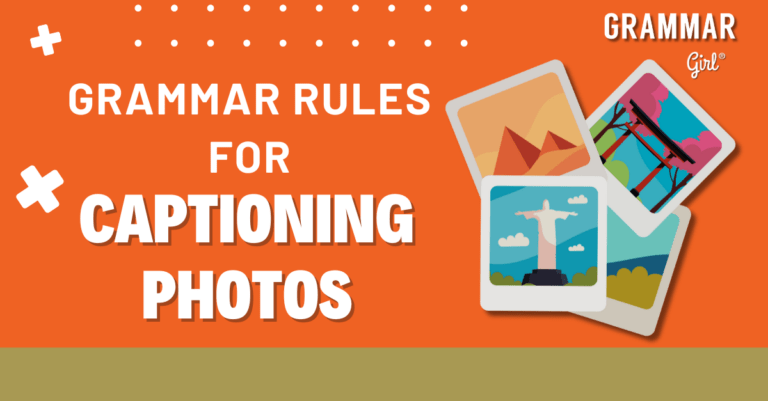This question comes from a listener. Linda said:
I’d like to see tips that address correct pronoun usage in social media captions. For example, if I caption a photo on a social media platform, I might type in: Taylor Swift and me.
Many people, however, would type in: Taylor Swift and I.
I use “me” under the assumption that the unwritten words preceding the caption would be: [This is a photo of] Taylor Swift and me.
Well, you’re right, Linda! Choosing between “me” and “I” in photo captions is trickier than it seems. As you noticed, a lot of people might default to writing “Taylor Swift and I,” but “Taylor Swift and me” is actually correct.
Understanding subject and object pronouns
The key to solving this grammar puzzle lies in understanding how subjects and objects work in English sentences. Think of subjects as the star performers in your sentence — they’re the ones doing the action. Objects, on the other hand, are on the receiving end of the action, or they come after prepositions like “of,” “to,” or “with.”
When we use pronouns like “I” and “me,” we’re making a choice based on whether we need a subject or an object. “I” is what we call a subject pronoun — it’s for when we’re the one doing something. “Me” is an object pronoun — we use it when we’re receiving the action or following a preposition.
So, let’s take a look at some examples:
- “I took a photo with Taylor Swift.” (In this sentence, “I” is doing the taking.)
- “Taylor Swift took a photo with me.” (“Me” comes after the preposition “with.”)
- “This is a photo of Taylor Swift and me.” (“Me” follows the preposition “of.”)
Photo captions are implied sentences
Now, here’s where Linda’s insight about photo captions comes in. When we write a caption like “Taylor Swift and me,” we’re actually creating a shortened version of a complete thought: “[This is a photo of] Taylor Swift and me.” Those unstated words at the beginning — “This is a photo of” — are important because they contain the preposition “of.” Since “me” is the object of this implied preposition, it’s the correct choice.
And here’s something interesting! People who write the incorrect “Taylor Swift and I” may not be using correct grammar, but they are giving us a perfect example of something linguists call hypercorrection — in other words, being so worried about making a grammar mistake that we end up making a different one. Many of us learned this habit because we heard constant corrections growing up, like: “It’s not ‘Me and Taylor went to the store,’ it’s ‘Taylor and I went to the store.'” These corrections stick with us, creating a sort of linguistic anxiety where “I” feels safer or more proper than “me.”
How to know when to use ‘I’ or ‘me’
A good trick to figure out which pronoun to use is to swap their position in your sentence and see if things still make sense in your implied sentence. So, let’s say you wrote: “Taylor Swift and I,” as in “This is a photo of Taylor Swift and I.” If you swapped the noun and pronoun, you’d have “This is a photo of I and Taylor Swift.” That sounds wrong, doesn’t it? When “I” sounds wrong when it comes first, then use “me” in your sentence instead.
What order do nouns and pronouns go in sentences?
But here’s a rule you should stick to if you want to be proper: Taylor Swift comes first! (Swifties will agree, I’m sure.) The traditional rule says we should put others before ourselves — so “Taylor Swift and me” rather than “me and Taylor Swift.” This isn’t just about grammar; it’s what linguists call a “politeness convention.” It’s like holding the door open for someone — a small gesture that shows consideration for others.
While we’re on the subject, let’s talk about a few other glitches people run into when they’re writing captions.
Do you need words like ‘a’ and ‘the’ in photo captions?
Have you noticed how photo captions often drop words like “the” and “a”? Like writing “Dog chasing ball” instead of “A dog chasing a ball”? This style, sometimes called “headlinese,” comes from newspaper caption traditions. With print newspapers, space was precious. But online and on social media, we have more room to play. So, using articles can make captions feel more natural and conversational. Go right ahead!
Do prepositions matter? Are you ‘in’ or ‘at’ the park?
Here’s another head-scratcher: Should you write “At Central Park” or “In Central Park”? The choice of preposition actually depends on how you’re thinking about the space. “At” suggests a point on a map, while “in” implies being inside the boundaries of a place. If you say “At Central Park,” it seems like you’re saying you’ve arrived there. But “In Central Park” implies that the photo was taken while you were spending some time in the park. Both versions are correct, but they can sometimes paint a slightly different picture in our minds.
Now, what about when you’re posting throwback pics? Should you write “In Paris last summer” or “Last summer in Paris”? Both are correct, of course, but there’s a little room for nuance here. Put Paris first if you want to emphasize the place itself, or put “summer” first if you want to highlight that traveling to Paris was something you’ve done in the past. Perfect for those hashtag-Throwback-Thursday posts!
So, there you go! A few simple grammar guidelines to help you caption your photos like a pro.




